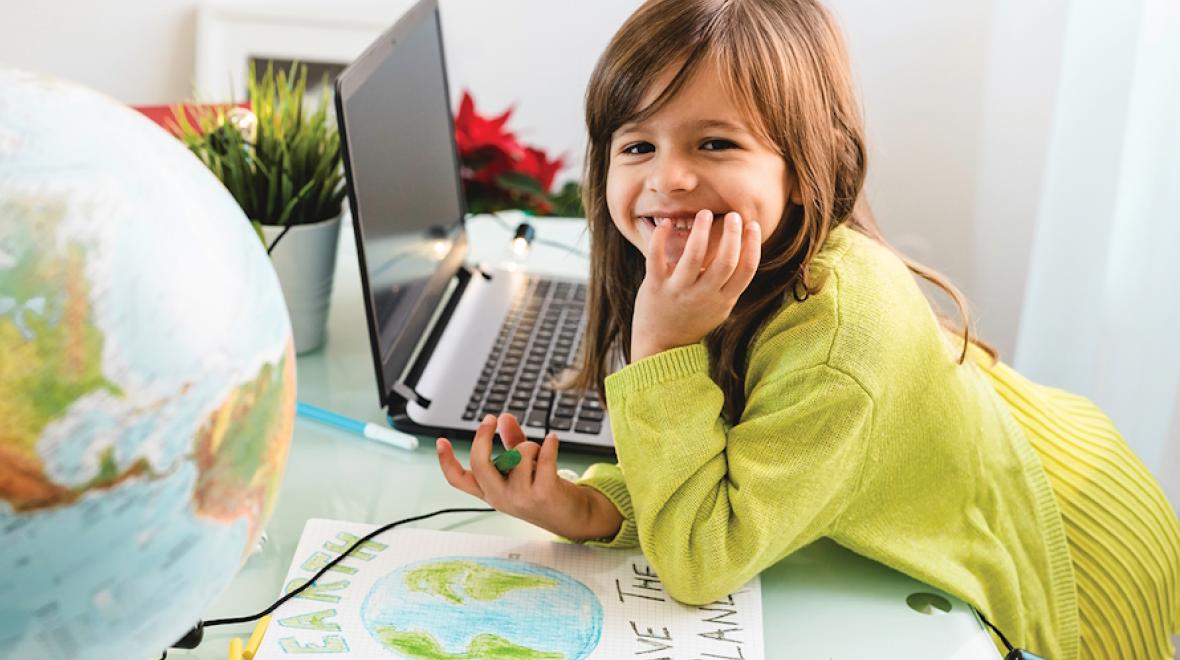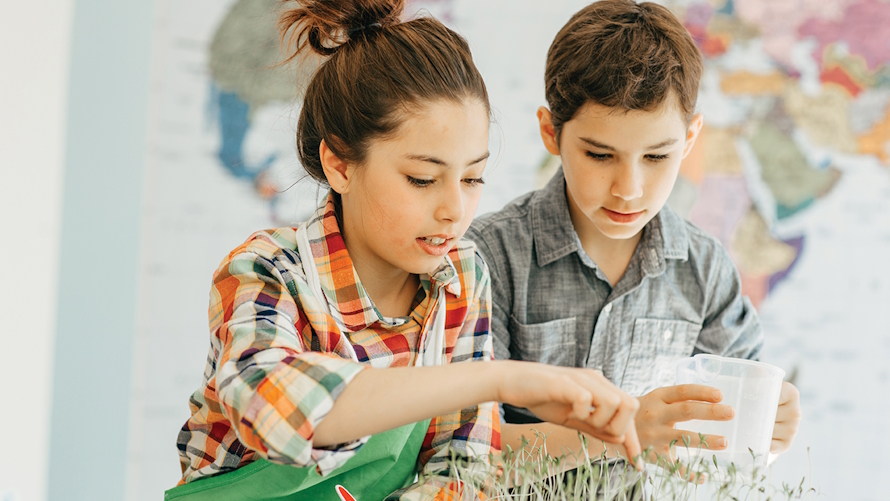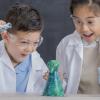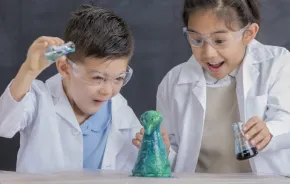
Politics aside, science leaves no room for doubt that climate change is real and that it’s the result of human activity. Washington state education standards call for climate education as part of scientific instruction. And in the left-leaning Puget Sound region, there’s not much political objection to teaching kids accurate climate science. But all of that still doesn’t guarantee that your child is actually getting a quality climate education.
Science standards
In 2022, a Pew Research Center survey in 19 of the world’s most developed countries found that climate change was considered the top global threat — even more threatening than the ongoing pandemic and issues regarding the global economy. But compared to other advanced nations, Pew reports, “concerns are relatively muted in the U.S.” As we begin to regularly experience the extreme weather and natural disasters associated with climate change, fewer people are clinging to climate change denial. Yet simply acknowledging the climate crisis is not enough. The next generation will need knowledge and skills to participate in a green economy and eliminate global dependence on fossil fuels. Unfortunately, the American education system isn’t exactly poised to provide that learning.
The nonprofit development organization FHI 360 recently released a report outlining strategic recommendations to help strengthen climate education. The first recommendation was to establish policies that support climate education at every level of the educational system. In the U.S., each state has its own education system, and those systems vary widely in quality. When it comes to climate science, only one state’s science education standards earned an A grade from the National Center for Science Education; six states received a failing grade. Washington state scored a B+.
“In many ways Washington state is leading the nation,” says Becky Bronstein, associate director of programs at EarthGen, a nonprofit that provides climate-focused professional development and classroom resources to educators in Washington state. Washington has adopted Next Generation Science Standards.
“Next Generation Science Standards came out a number of years ago as part of a nationwide effort to reimagine how science teaching and science learning looks. There’s also state-specific standards that are particular to climate and human-impact topic areas,” Bronstein explains.
What kind of policies would bring Washington’s grade up to an A? Bronstein says, “The standards can definitely be improved. There’s plenty of room for adding more details, especially as the science and its complex intersections become more clear.” She also suggests that a mandatory professional development policy would ensure that all teachers have some training in climate education.
But state policies and science standards are only the first step, and they don’t always translate to effective instruction in the classroom. Sometimes, they don’t translate into any instruction at all.
State of climate education
“There’s a whole mess of variables of why students aren’t receiving science education, let alone climate change and climate justice learning,” says Bronstein. Some of these reasons are pointed out in two of the recommendations made in the FHI 360 report: Effective climate education requires access to high-quality curricula and materials that are grounded in scientific data; and educators need training and professional development to deliver those materials.
When districts have sufficient funding, they often adopt and purchase curricula for all teachers to use. This adoption process can take years, including a pilot year to test the curriculum before rolling it out districtwide with training (which also costs money) for the teachers who will implement it.
“Curricula quickly can become outdated, sometimes they don’t align with current standards, there might be something problematic about it or the materials that go with the curriculum run out and there’s no funding to get those things. It’s much more complicated than just ‘This school has curriculum for this topic.’ If they have adopted curriculum, it doesn’t always mean that everything is just going along swimmingly,” says Bronstein. But many schools would love to have the problems associated with purchased science curricula. Every district has its own educational priorities and funding limitations, and science is often the area that is neglected as schools focus on literacy and arithmetic.
In the absence of officially sanctioned and provided science curriculum, there are a lot of open-source science resources available online. But using them puts the burden on teachers to organize the information, collect any relevant materials (often with their personal money), and tie the content to district requirements and state standards. Teachers are already overburdened, but this effort is especially challenging when it comes to climate science.
“Climate change is complex, and it has also been such a politicized issue. It’s scary and brings up a lot of different emotions. Teachers need support in how to navigate all those different complexities and how to bring that into their classroom,” says Bronstein. Climate science was not taught in schools back when most teachers were students themselves, and it is rarely taught as part of teacher training, which usually focuses more on pedagogy than content. Professional development is needed to ensure that teachers understand the science they need to teach.
“Professional development is not just giving the content knowledge, it helps give the confidence and preparedness to bring it into the classroom,” says Bronstein.
Many teachers do not feel confident that they are prepared to teach climate science. Their comfort level in presenting this information may be further undermined by the culture of the community and level of support from their school administration in responding to any potentially negative feedback they may receive.
“When understanding all the different factors that a given community is facing, for some communities, even just equipping educators to bring the words ‘climate change’ into the classroom is a huge step forward,” says Bronstein. But when all those factors align, schools may provide an interdisciplinary approach to climate science that can extend beyond the classroom to the community.
“Students are actually taking action around climate change, thanks to the learning that they have had in the classroom, which is thanks to professional development that their teachers received,” says Bronstein. Most communities fall somewhere in between the extreme of no science and the ideal of empowerment to take action.
State of local schools
So, is your child learning climate science?
“It’s kind of the nature of our education system that it’s hard to ensure that every student is equipped to perform to a particular standard’s expectations. [Results vary] depending on resources and methods of evaluation. I’m sure that parents have heard about state testing,” says Bronstein. Standardized testing is indeed its own can of worms. Although standardized tests are often used to judge individual student performance and determine their placement, the tests are actually designed to evaluate the school’s effectiveness. OSPI’s Washington State Report Card provides a sometimes sobering perspective on that front. Statewide, just under 43% of students met science standards last year.

In the Puget Sound area, “People have not just heard of climate change, they want to do something about it. But this area of the state has a lot of those conflicting variables — differences in resources and other challenges with supporting students in other ways — so climate change is often put on the back burner. Even though teachers might be excited about it and want to do something, they just might not have the time or the energy or the capacity to do it,” says Bronstein.
You might find out which science curriculum your child’s school uses on the school or district website. But unless you’ve been involved in a curriculum selection process (and you really should, if you can), that information might not mean much to you. The best way to know for sure what, or if, your child is learning about climate change is to ask. Talk to your student and their teacher about what they are learning in their classroom. Talk to the district administration and school board about what’s being taught at different grade levels.
Quality climate education should include three things:
Scientific fundamentals
It should answer the questions “What is climate change?” “How do we know the climate is changing?” and “How do we know humans are causing it?” The lessons should be connected to data and help students understand how data is used to inform conclusions.
Local impacts
Climate science is complex, but it is not abstract. Students should learn about specific, local impacts of climate change.
“Here in Seattle, I don’t necessarily need to learn about polar bears and melting ice caps. That just makes me sad and makes me feel a bit powerless. But if I’m learning about flooding and erosion happening on the coast, or about how I’m living in a place that now experiences smoke regularly in late summer, that impacts me and makes me want to understand why. And then I want to know what I can do about it,” says Bronstein.
Agency to action
The science is clear: Human activity is responsible for climate change. That means human activity is required to stop it. A theoretical understanding of climate change is useless unless students learn how they can be part of the solution. Learning about solutions is not just pragmatic. It also provides students with a sense of agency, which is a valuable social-emotional learning experience as well.
Take action
If your child’s science education falls short, you can take action yourself.
“We need everyone on board, including parents — now more than ever,” says Bronstein.
At home, you can engage in environmental action as a family and read books to learn about the environment. At school, parents can take leadership roles in projects like after-school green teams or cafeteria food waste programs. Especially in our part of the state, many environmental education organizations can help with projects like these and also provide free resources to teachers.
“There’s all sorts of interesting programs and great work done by community-based organizations like EarthGen and others that directly engage with students,” says Bronstein. “EarthGen provides NGS-driven [Next Generation Standards], culturally sustaining resources that are fun and interesting. They all move students toward taking some kind of action so that they feel they have agency and are empowered by their learning.”
Parents can also advocate with the district to allocate resources for climate education and encourage integrated learning approaches that don’t pit academic subjects against one another. When you vote, from the school board to Congress, be sure your candidate supports education and the environment. The National Education Association produces an education scorecard for Congress. Washington Conservation Action endorses environmentally minded candidates across the state.
Community organizations that support environmental and climate scienceThis is just a handful of the many organizations supporting parents and teachers in our area with educational programs and resources. |











